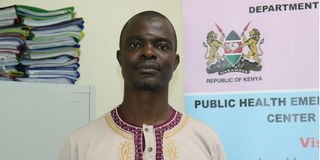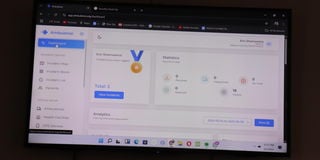Nakuru’s nerve centre: How a rapid response team is stopping outbreaks before they spread

Moses Obiero, manager of the Nakuru Public Health Emergency Operations Center (PHEOC) during an interview with Mtaa Wangu on June 3, 2025.
When COVID-19 hit Kenya in 2020, it exposed major gaps in local emergency preparedness.
In Nakuru County, the pandemic became a turning point, prompting the creation of the Public Health Emergency Operations Center (PHEOC), a facility that now plays a central role in monitoring, detecting, and responding to health threats.
“COVID-19 underscored the need for a localized response system,” says Moses Obiero, manager of the Nakuru PHEOC. “Before, we relied entirely on the national response center. However, when we recorded our first case in March 2020, we realized we needed to strengthen our capacity. By November that year, the PHEOC was established.”
The center was set up not only to manage outbreaks like COVID-19 but also to prepare for emerging and re-emerging diseases.
Its vision is to coordinate rapid response through collaboration among different sectors- public health officers, clinicians, police, and investigators.
“We needed a central point to unite everyone there,” Obiero explains. During COVID-19, for example, we had to engage multiple agencies for contact tracing and community sensitization.”
The system in Nakuru is unique in how it combines human intelligence with technology.
A key operation of the center is the M-Dharura, a mobile-based application that allows over 3,300 Community Health Promoters (CHPs) to report early signs of health events.
The app works even on basic mobile phones via SMS, making it accessible in rural areas.
CHPs monitor households and report using code signals such as when two or more people exhibit similar symptoms.
These alerts are received by 47 Community Health Assistants (CHAs), who verify the information, collect samples if necessary, and initiate the first level of response.
Sub-county teams composed of 11 people then assess the risk, and if needed, escalate the situation to the PHEOC.
“We coordinate the outbreak response, support the teams on the ground, and manage resource mobilization,” Obiero says. “Our team also monitors everything from the backend and can intervene at any point.”
The PHEOC is staffed by 12 people—five of whom operate the call center, responding to emergency calls and dispatching ambulances.
The remaining seven form the technical team, which handles data analysis, system monitoring, and inter-agency coordination.

Dashboard of the ambulensi system used by emergency medical technicians to coordinate ambulances in times of need. Photo taken on June 3, 2025.
“This system wouldn’t work without people and technology,” Obiero notes. “It’s the blend of real-time data and trained personnel that makes our response effective.”
Nakuru is one of 28 counties in Kenya with an emergency response center, and it has become a model for others.
The U.S. Center for Disease Control and Prevention (CDC) in Atlanta, along with county teams from Meru, Homa Bay, Nairobi, and Nyandarua, have visited to learn from Nakuru’s setup. Nyandarua later established its center, inspired by Nakuru’s success.
The PHEOC continues to be instrumental beyond COVID-19 and was used during the recent Mpox outbreak and remains vital in tracking and containing disease threats.
In addition to the app and call center, the county relies on health facility data and routine monitoring to detect abnormal spikes in illness.
“A key principle in disease surveillance is early detection,” Obiero emphasizes. “The sooner we know something is happening, the faster we can respond and stop it from spreading.”
With the rising threat of emerging diseases and climate-related health risks, Nakuru’s emergency response center exemplifies how counties can build resilience through strategic investments in human resources and technology.
As more counties aspire to copy this model, Nakuru’s experience provides a template for community-focused, public health frameworks that aim to anticipate and mitigate challenges instead of merely reacting to them.
